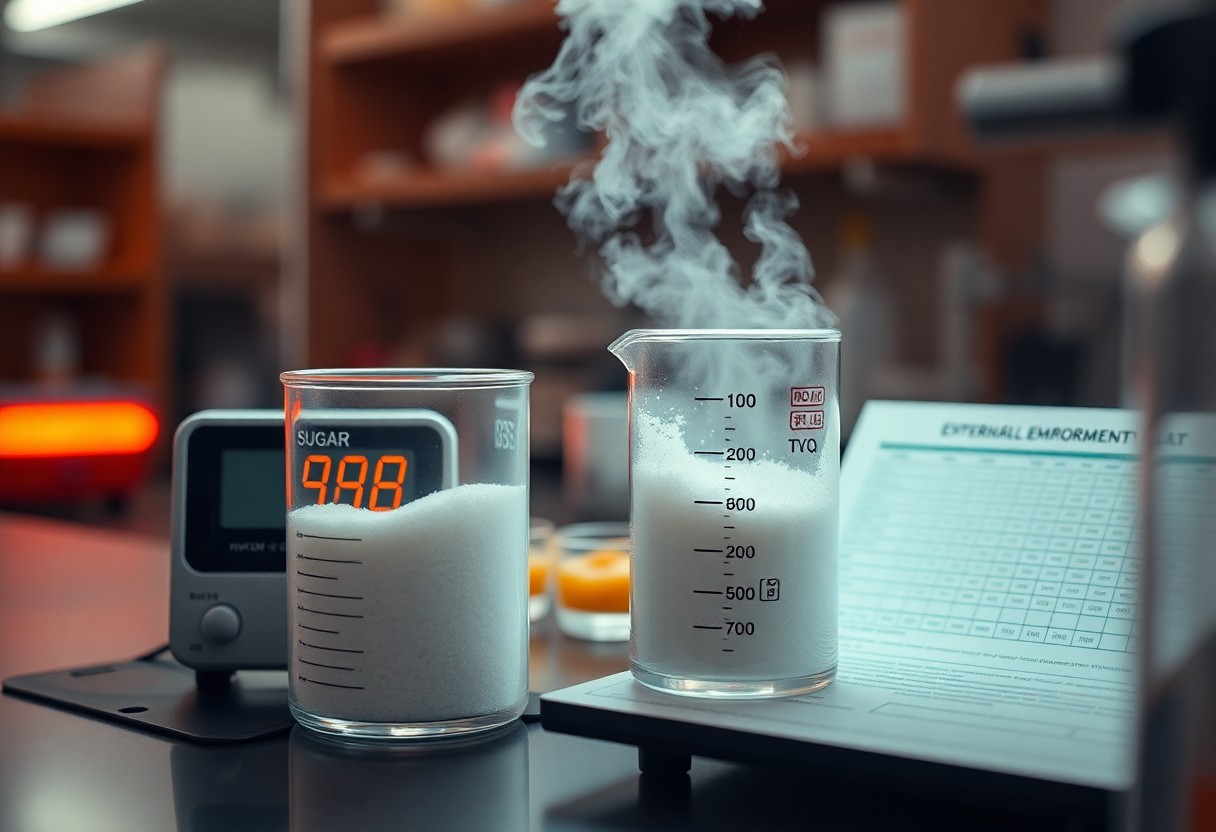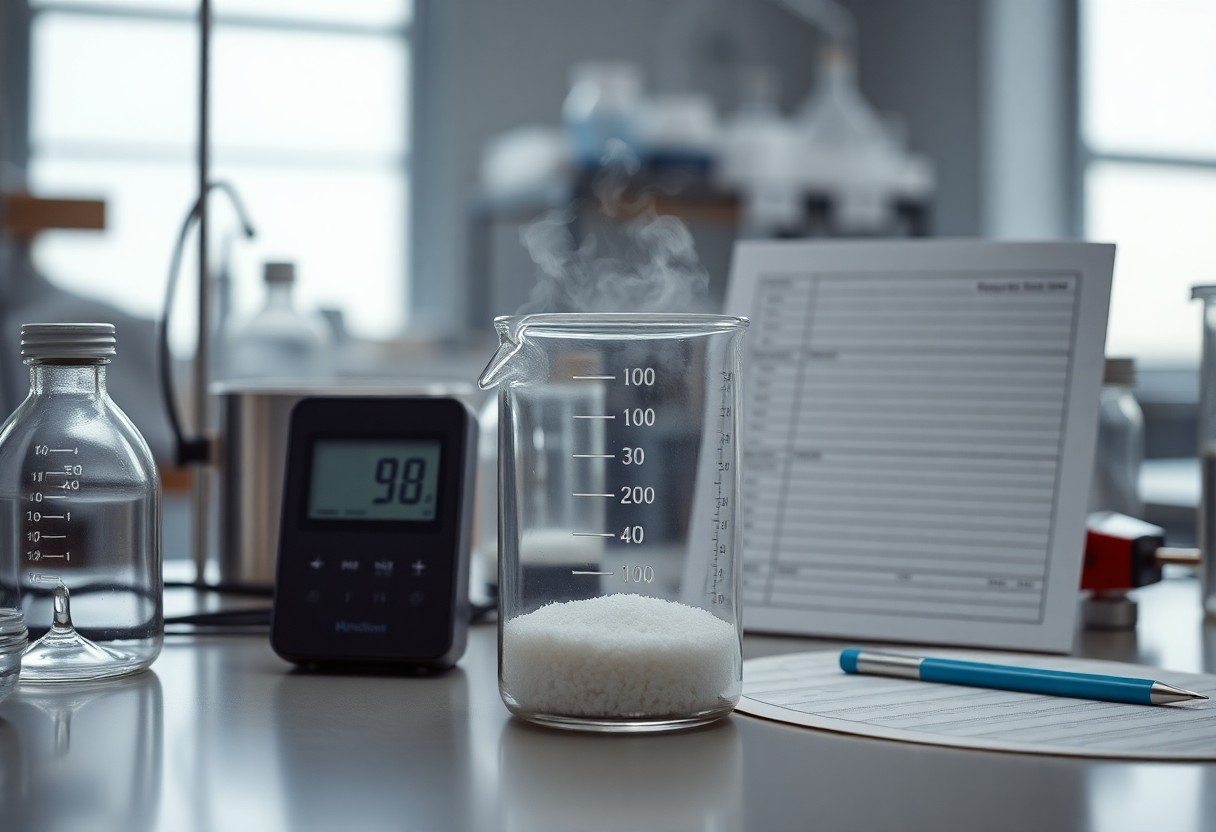Just like magic, you might wonder how heat affects sugar as it transforms from granules to a gooey syrup. In this blog post, you will discover the science behind why sugar melts faster when heated and the various factors that contribute to this process.
You will learn about the importance of temperature, the types of sugar, and safety precautions to take when experimenting with heating sugar in your kitchen.
Dive into the sweet world of sugar melting as you explore the fascinating reaction that occurs when heat is applied.
Key Takeaways:
- Sugar has a melting point that is influenced by heat, and when subjected to higher temperatures, it does melt faster compared to room temperature conditions.
- The experiment illustrates the physical transformation of sugar from a solid to a liquid state when heated, demonstrating key concepts in thermodynamics.
- Factors such as the type of heating method and the purity of sugar can affect the rate at which sugar melts, highlighting the importance of experimental controls.
Understanding Sugar and Its Properties
As you probe into the world of sugar, it’s vital to recognize that sugar is more than just a sweetener; it has fascinating properties that affect how it behaves when heated. Understanding these properties can help you comprehend why sugar melts and the factors influencing its melting process, which is particularly intriguing during cooking and baking.
Chemical Composition of Sugar
Among the various types of sugar, sucrose (table sugar) is the most common, composed of carbon, hydrogen, and oxygen atoms. Its molecular formula is C12H22O11, showcasing a complex arrangement that contributes to its sweetness and solubility in water. This unique chemical structure allows sugar to interact with heat in distinct ways, influencing its melting point and behavior under various temperatures.
Physical State of Sugar
After considering the chemical makeup, you should also note that sugar exists in different physical states, primarily as a solid. At room temperature, sugar appears as crystalline granules, providing a familiar texture. However, as heat is applied, these granules undergo significant transformations, affecting their structure and properties.
Another important aspect of sugar’s physical state is its ability to dissolve in liquids and change form when heated. When you heat sugar, it transitions from a solid state into a syrupy liquid, making it easier to mix with other ingredients in your recipes. This transformation can lead to *caramelization*, which produces *rich flavors* and *colors*, enhancing your dishes. However, be cautious, as heating sugar too long may cause it to burn, resulting in a bitter taste. Understanding these properties enables you to manipulate sugar effectively in your culinary endeavors.

The Science of Melting
Any discussion about melting starts with understanding the physical changes that occur when a substance transitions from a solid to a liquid state. The melting process involves the absorption of heat, which causes molecular bonds to weaken and eventually break. This transformation allows the molecules to move freely, leading to the liquid state. When you heat sugar, it undergoes this fascinating change, making the experiment visually appealing and scientifically interesting.
Understanding the Melting Point
Around 186°C (367°F), sugar reaches its melting point, where the solid structure collapses under heat. This phenomenon is not immediate; instead, you may notice changes in texture and appearance as the temperature gradually rises. Observing these changes can help you better comprehend the unique characteristics of sugar and its behavior under thermal conditions.
Heat Transfer Mechanisms
An vital aspect of melting involves the transfer of heat, which occurs through three primary mechanisms: conduction, convection, and radiation. This transfer not only affects the melting process but also influences how quickly sugar dissolves or melts when heated. With conduction, heat moves directly from one object to another; convection involves the movement of fluids transferring heat, while radiation occurs through electromagnetic waves. Understanding these mechanisms allows you to grasp how energy exchange impacts your cooking, baking, or candy-making adventures.
Transfer of heat in your cooking environment can significantly influence the melting of sugar. Conduction happens when the sugar comes in direct contact with a heat source, such as a pan. Convection plays a role when you’re using a liquid, as the warm liquid circulates around the sugar, helping it melt evenly. Lastly, radiation from a stovetop or oven can also contribute, but it’s often less efficient. Overall, knowing how heat transfers can help you control melting rates, ensuring your sugar doesn’t burn while achieving that perfect liquid state.

Experimental Setup
After gathering your materials, you’ll be ready to investigate this exciting experiment. Set up your workspace in a heat-resistant area, ensuring you have access to a reliable heat source and protective gear. This will help you manage the experiment safely while observing how sugar reacts to heat in real-time.
Materials Needed
Across your kitchen, you will need a few important items for this experiment. Gather granulated sugar, a heat source such as a stove or hot plate, a saucepan, a thermometer, and a spatula. Additionally, have a heat-resistant surface or tray ready for your observations, as well as safety gloves to protect your hands.
Procedure Overview
An easy-to-follow procedure will guide you through the experiment effectively. Start by heating the saucepan on the stove while adding measured amounts of sugar at regular intervals. Use the thermometer to monitor the temperature and note any visible changes in the sugar’s state. This will help you determine the effect of heat on sugar dissolution.
To conduct the experiment, you will begin by measuring precise amounts of granulated sugar and placing them into the heat-resistant saucepan. Once the pan is heated, carefully observe the sugar as it heats up. Use your thermometer to track the temperature while stirring occasionally with a spatula. Pay attention to how quickly the sugar melts and any significant temperature changes that occur. By the end of this experiment, you’ll have a solid understanding of the relationship between heat and sugar melting rates.
Results of the Experiment
Despite initial assumptions, the results of the experiment revealed intriguing insights about sugar’s melting behavior when heated. You may have expected sugar to melt uniformly under heat, but varying conditions, such as the heat source and the type of sugar, produced different outcomes. The experiment demonstrated a notable difference in melting rates that were influenced by these factors, paving the way for deeper understanding and exploration of sugar’s physical properties.
Observations During Heating
At the onset of heating, you might have noticed changes in sugar’s texture and color. As the temperature increased, the sugar granules began to clump together, leading to the formation of liquids. This transformation was characterized by a gradual caramelization that altered the sugar’s aroma, creating a sweet and rich scent in your kitchen!
Comparative Analysis of Melting Rates
During the experiment, you tracked the melting rates of different types of sugar, including granulated, brown, and powdered sugar. The following table outlines these observations:
Melting Rates of Different Sugars
| Type of Sugar | Melting Rate (minutes) |
|---|---|
| Granulated Sugar | 5 |
| Brown Sugar | 7 |
| Powdered Sugar | 4 |
This data illustrates that granulated sugar has the quickest melting rate, while brown sugar takes longer due to its moisture content. All the sugars melted differently, showing how their physical structures contribute to their melting behaviors. Understanding these dynamics helps you in your culinary adventures, ensuring that you select the right type of sugar for optimal melting in recipes!
Factors Influencing Melting
Many factors can influence the melting of sugar when heated, altering both the speed and the final texture. Consider the following elements:
- Type of sugar
- Heating methodology
- Heat source
- Moisture content
Knowing how these factors interact can help you achieve the desired melting results in your sweet experiments.
Type of Sugar
Against common belief, not all sugars melt at the same rate. Different types of sugars, like granulated, brown, and powdered, possess unique melting points and properties, impacting how swiftly they dissolve when heated. Understanding the specific characteristics of each sugar type allows you to tailor your heating process effectively.
Heating Methodology
With proper heating methodology, you can significantly influence the melting process of sugar. The approach you take—whether it’s Direct heat, Indirect heat, or using a double boiler—will determine how evenly and efficiently your sugar melts.
Even more importantly, using low heat can prevent your sugar from caramelizing or burning, which is particularly dangerous when working with high temperatures. Keeping your sugar stirred and using a candy thermometer can provide better control over the melting process. As you experiment, be aware that different methodologies yield varied outcomes that can affect the overall taste and consistency of your sweet creations.
Implications and Applications
To understand the broader implications of how sugar melts, you can explore various applications ranging from culinary arts to industrial processes. This knowledge not only enhances your cooking techniques but also has significant importance in manufacturing and food production.
Culinary Uses of Melted Sugar
Implications of melted sugar in cooking are many; you can create caramel, toffee, and other delectable confections. The process of melting sugar transforms its texture and flavor, enabling you to craft gourmet desserts and enhance your flavor profiles in both sweet and savory dishes.
Industrial Relevance
Melted sugar also plays an imperative role in various industries. In the production of confectionery and bakery items, mastering the melting process can lead to higher quality products, more efficient manufacturing, and cost-effectiveness.
Even in larger-scale industrial settings, your understanding of sugar’s melting properties can offer benefits. Enhanced melting techniques can yield products with improved texture and taste, ensuring customer satisfaction. However, improper handling of melted sugar can be hazardous due to its high temperatures, posing risk of burns. Therefore, prioritizing safety when working with melted sugar is vital for your well-being and productivity.
Summing up
Now that you understand how heat affects sugar melting, you can appreciate the science behind your sweet treats. By applying varying temperatures, you can observe how quickly and efficiently sugar melts, enhancing your culinary skills. Whether you’re baking or experimenting, knowing the melting point and behavior of sugar under heat will undoubtedly elevate your kitchen endeavors. Enjoy your sweet experiments!
FAQ
Q: Does sugar melt faster when heated compared to being at room temperature?
A: Yes, sugar melts faster when heated. When sugar is subjected to heat, the energy increases the movement of its molecules. This process allows the sugar to transition from a solid state to a liquid state more quickly than when it is at room temperature.
Q: What is the melting point of sugar?
A: The melting point of granulated sugar (sucrose) is approximately 186°C (367°F). When heated, the sugar will gradually turn into a syrupy liquid as it reaches this temperature.
Q: Can the type of heat source affect how fast sugar melts?
A: Yes, the type of heat source can influence the melting rate of sugar. Direct heat sources like a stovetop can melt sugar quickly, while indirect heat sources such as a water bath may result in a slower melting process. The intensity and evenness of the heat distribution play vital roles.
Q: Are there different types of sugar, and do they melt at different rates?
A: Yes, there are various types of sugar, such as granulated sugar, powdered sugar, and brown sugar. While they all contain sucrose, their textures and moisture content can lead to differences in melting behavior. For example, powdered sugar may dissolve or melt more quickly due to its smaller particle size and higher surface area.
Q: What happens to sugar when it is heated beyond its melting point?
A: When sugar is heated beyond its melting point, it undergoes caramelization, which transforms it into a deep amber liquid with a distinct flavor and aroma. This process typically starts around 160°C (320°F) and involves complex chemical changes that develop its characteristic taste, but caution should be exercised to prevent burning.